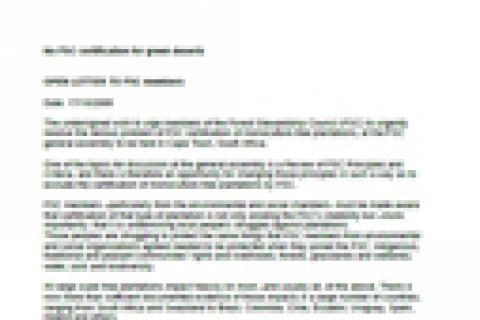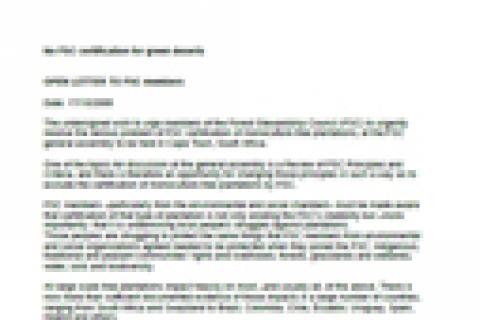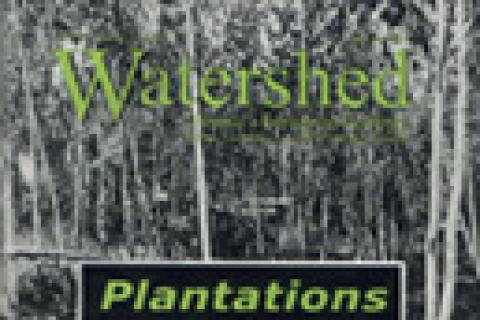Bananas, in terms of gross value of production, are the world’s fourth most important food crop after rice, wheat and maize. Latin America dominates the world banana economy, where they are cultivated mostly in large mono-crop plantations.
Other information
According to a recent official report, Argentina has lost 70 per cent of its native forests: out of 105 million hectares of forests, only 33 million are left today. Those most affected are the native forests in the northern and central regions of Argentina in the Provinces of Santiago del Estero, Salta, Chaco, Formosa, Misiones, Entre Rios and Santa Fe. It should be stressed that in a sector of the Province of Salta, the annual deforestation rate is three times higher than the world average.
Between 1950 and 1975, the area of human-established pasture lands in Central America doubled, almost entirely at the expense of primary rainforests. The numbers of cattle also doubled, although the average beef consumption by Central American citizens dropped. Beef production was exported to markets in the United States and in other Northern countries.
Between 1966 and 1978 in Brazil 80,000 km2 of Amazon forests were destroyed to give way to 336 cattle ranches carrying 6 million head of cattle under the auspices of the Superintendency for Amazon Development (SUDAM).
PRESS RELEASE -
In a National Consultation held in Delhi on August 7, 2004, several civil society organisations in India including major national alliances on mining, forestry and dams and hydro power, rejected the World Bank’s Country Assistance Strategy (CAS) 2004 on the grounds of:
There is no smoke without fire, and in this case, the fire is in Spain, where the ENCE paper company has a pulp mill that for many years has contaminated the Pontevedra river mouth. Although the company was finally condemned and its executives ordered to pay fines and sentenced to prison, the environmental “inheritance” continues (see WRM bulletin 75). The local population is asking for the “factory to be closed” to enable them to “recover the shell-fishing areas” and “the fisheries.”
A new cycle in the increasing of production of eucalyptus pulp for export began in northern Espirito Santo, the southern region of Bahia and north-eastern Minas Gerais, with the opening in 2002 of the new Aracruz Celulose mill. This company increased its annual pulp production from 1.2 to 2.0 million tons, and expects to reach 2.4 million tons. Veracel Celulose, jointly owned by Aracruz and the Swedish-Finnish Stora Enso, is currently building its first eucalyptus pulp mill, the biggest in the world, with an annual production capacity of 900 thousand tons.
Twenty-two months after the beginning of its construction and almost five years behind schedule, the Valdivia mill started operating in the Lakes Region. The announcement was made on 30th January by Alejandro Pérez, General Manager of Celco (Celulosa Arauco y Constitución, forestry subsidiary of the Angelini group), who called this project a “historical investment”.
Uruguay has been one of the countries in the region that has best and fastest fulfilled the duties others have dictated.
Already in 1951, a joint FAO-World Bank mission made a series of recommendations regarding the country’s forestry development, which was the basis for the forestry laws adopted in 1968 and 1987. Their vision implied the promotion of suitable species for the timber industry in the framework of an export model, in which forest management is just another business or manufacturing activity.
Sent by World Rainforest Movement, Forest Peoples Programme and Environmental Defense, on behalf of 47 International NGOs.
Mr. James D. Wolfensohn
President
The World Bank
1818 H Street, NW
Washington, D.C. 20433
Via Fax: 202 522 3031 & Mail
Dear Mr. Wolfensohn,
We thank you for the opportunity to provide comments on the Bank’s draft policy for adjustment lending, now named Development Policy Lending (O.P. 8.60).
by Andrew Cock.
In "Plantations are not Forests. Commercial Tree Plantations in the Mekong Region".Vol. 9 No. 3 March - June 2004. Published by Towards Ecological Recovery and Regional Alliance (TERRA)
Pulp and paper production in Kenya is presently dominated by one firm, Pan African Paper Mills (Panpaper), which is a joint venture between the Kenyan Government, the World Bank’s private investment arm International Finance Corporation (IFC), and Orient Paper Mills, part of the Birhla group from India. The pulp mill was established in 1974 and is based in Webuye town, with a population of some 60,000 people, on the banks of the Nzoia River which drains into Lake Victoria.
‘Pulping the South’ by Larry Lohmann and Ricardo Carrere was a watershed publication for many groups and individuals around the world. Concerned people had been aware of many issues and problems associated with the expansion of industrial monoculture tree plantations in Southern countries, but it was this WRM publication that made the world sit up with a jolt.



